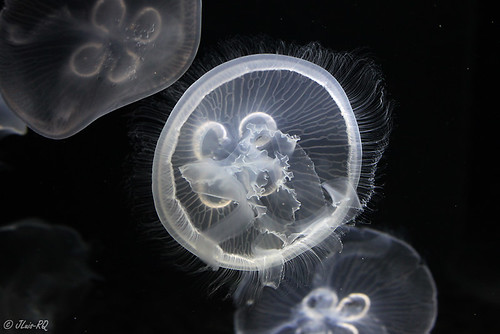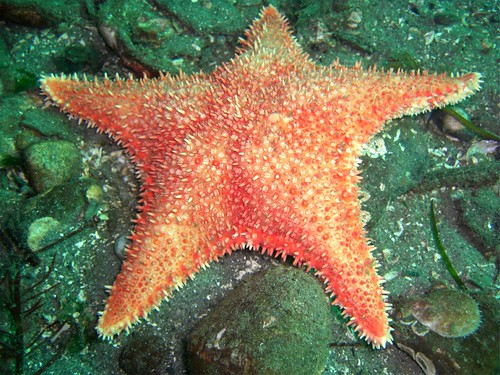This project originally began because we were studying a relationship between two near-Arctic sea star species. One in the sub-Arctic North Pacific (called Hippasteria spinosa) which occurs widely in Alaska/the Aleutians Islands, Washington, etc.
Hippasteria is a cold-water animal and is important as a predator of deep-sea corals and cnidarians. Here was a blog about some prior species I've worked on...
 |
| Image by Davidtodd via Flickr |
You can test the relationships between these species using genetics to determine if they are closely related. Sometimes you can even determine if they are literally the SAME species perhaps separated by time and the history of the region. Ice bergs and glaciers perhaps??
As it turns out, we found something intriguing...
The more we sampled these 2 species, the more we realized that scientists had assumed that Hippasteria was present from North Pacific to Arctic to North Atlantic.. it turns out no one had ever collected any from the Arctic!! (i.e., nothing in between!)
And to add more to the mystery, there were taxonomic accounts which indicated that there were accounts of the Atlantic species, H. phrygiana in unusual places..namely.. New Zealand!!
We looked at the distribution of this and related species..it turned out that H. phrygiana or species which closely resembled it were present all over the world!
A two-year effort on the part of myself and Dave Foltz was launched!
We managed to obtain samples of Hippasteria from all colleagues over the world! Our coverage spanned 3 oceans across 2 hemispheres!
- the North Pacific-Aleutian Islands/Alaska
- the South Pacific-Chile, Solomon Islands and New Zealand
- the Kerguelen Islands in the South Indian Ocean (sub Antarctic),
- the North Atlantic, the North Pacific-Aleutian Islands
What we found was pretty amazing. It turns out that from all the populations of similar looking Hippasteria around the world?
There was only ONE species.
We extracted tissue and DNA from multiple populations and found that the genetic differences among the many populations found around the world were minute. SO minute that there was really no reason they should be regarded as separate species..
BUT there was structure. Different populations show SOME natural differences relative to other populations.
The following two diagrams show what's called "haplotype networks" for the two genes that we studied. The size of the circle indicates the sample size, whereas the different colors shows the region and the lines show the connectivity between the regions sampled..
 |
| Fig. 2 Network for COI haplotypes |
We sampled two genes but I've only shown one network so that you get the idea. Basically, there ARE population differences between the populations in the North vs. South Pacific vs. the ones in the North Atlantic..
One Species Around the World!
You can think of this in the same way that human beings show differences (also called heterogeneity) between populations but are all basically considered the same species. In population genetics-its often the amount of difference between isolated populations that mounts up to indicating different species.
There's actually a LOT of animals that belong to only one species that are found all over the world (other than humans that is!)
Usually though, its small species (such as the brittle star Ophiactis) (see here) that get carried everywhere or perhaps things that swim like jellyfish...

BUT this is still kind of unusual. One species that lives on the sea bottom?? From a group of animals not known to be quick travellers or even particularly well travelled? This species' spread is probably via the marine larvae which were carried via ocean currents...
Widely distributed species often wreak havok with people who describe species (i.e. taxonomists).
Do differences between populations mean many species? Or do they mean one species occurring widely?
In this case-its ONE species. This also has a pretty huge impact on taxonomy. In the old days, many species were identified as new because they were found in new places, or far away from where prior species were known. A lot of the technology to test these relationships was not yet available...
But now that we know, ALL those species names that fall within the range of our study will be suppressed (via international rules) by the oldest name-Hippasteria phrygiana. So, for example, the North Pacific Hippasteria spinosa (described in the 20th Century) will now be called H. phrygiana (described in the 19th Century) because they've been shown to effectively be the same.

Another spin- HOW FAST did they Spread Out? and from where?
Further dynamics!
- There was apparently NO gene flow across the Arctic and we couldn't find any records of this species currently present in the Arctic. So, in one sense they took the long way around....
- Modelling studies of the genes showed that the three populations had been diverging with little or no connection (i.e. gene flow) for the past 50 to 75,000 years (roughly the late Pleistocene when).
- That means that this species spread out over the world's oceans QUICKLY (not even a million years!) and not that long ago! That in itself is pretty surprising...
- Could the distribution of these animals (originally spread via swimming marine larvae) be affected by glacial (i.e. ice) cover?
- Although evidence was not concrete-it seems likely that Hippasteria spread out from the Pacific to the Atlantic.
- This was not a case of spread from human transport. We know this because one of the genes we looked at had changed too much to have occurred in a human time frame.
So there you have it! A story about a species of starfish living in THREE Oceans! Evolved wide and Quickly! Not invasive and not an animal that floats around the world as an adult!





3 comments:
Great story!
Terrific summary of several ideas, hope it inspires the search to look for other cases, too. Who knew this common species held such a story behind it? Thanks!
thanks! always great to have pos feedback-esp. so early on!
Post a Comment